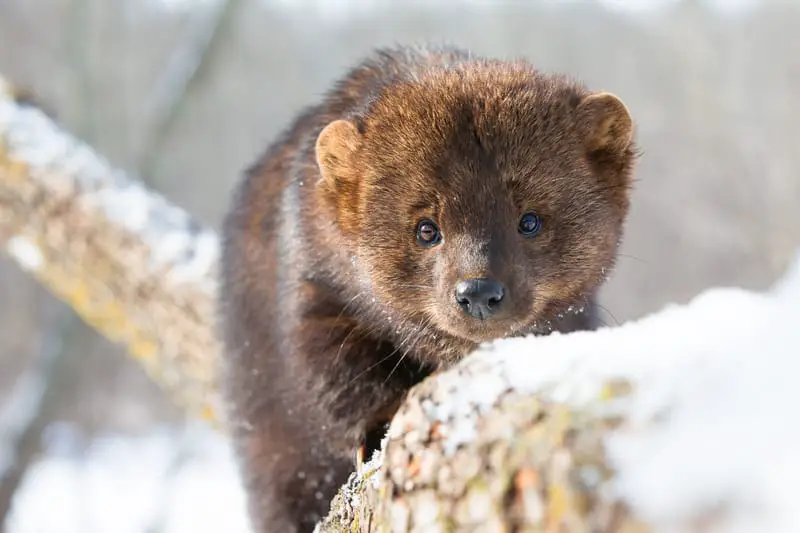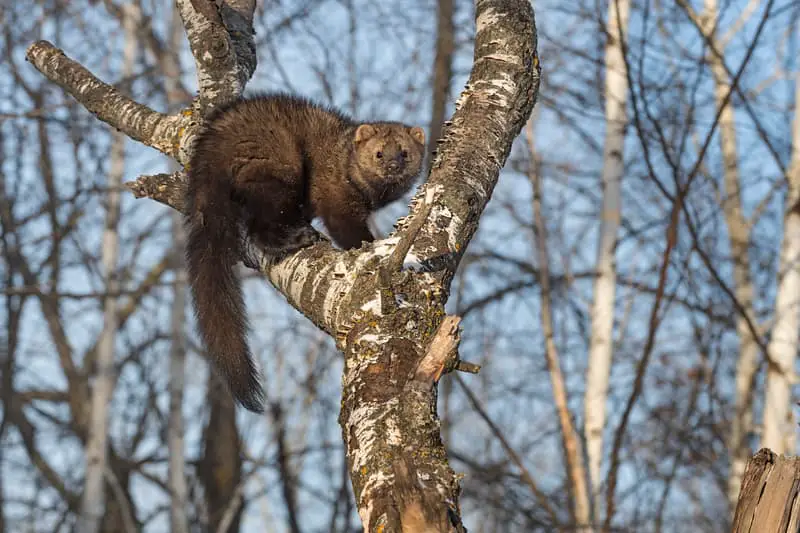The fisher or fisher cat (Pekania pennanti) is a small dark colored carnivorous mammal that is native to the forests of North America in general and Pennsylvania in particular. Some other common names that the fisher cat is known by, depending on the region, are pekan, wejak, or tree otter. These animals are endemic to the forests of New England and the mid-Atlantic United States. As this region was colonized by European settlers, a lot of the forests were cleared for agriculture and industry. Subsequently, many wildlife species were regionally expatriated. This is what happened to Pennsylvania’s fisher cat population.
At one time, fisher cats were expatriated from the state of Pennsylvania. However, this is no longer the case. Much of Pennsylvania’s forest land is back. The fisher cat population in the state is doing well and expanding. Per a 2013 report in LancasterOnline, there are fisher populations in at least 57 of the state’s 67 counties.
Before colonial times, most of Pennsylvania was covered in forest. At this time, fisher populations were distributed across most of the state. However, with European colonization, most of what is now present-day Pennsylvania underwent rapid deforestation in the late eighteenth century and the nineteenth century. By the late 1800s, most of Pennsylvania was deforested. Because of the removal of Pennsylvania forests, along with unregulated trapping, fisher populations plummeted, and by the early 1900s, they were all but gone. The last native fisher cat in Pennsylvania was killed either in 1921 or 1923.
What Do Fisher Cats Look Like?
Fishers are the second largest member of the weasel family (Mustelidae) in the Commonwealth of Pennsylvania. The largest is the river otter.
Visually, fisher cats resemble a larger version of an American marten. They have a typical weasel shape that consists of a well-furred long body. Additionally, they have short legs relative to the size of their bodies. They also have a long tapering tail that contributes about 40% of their total length.
Their hair is brown, sometimes trending to blackish brown. They have white guard hairs interspersed with brown on their chest and shoulders. Also, occasionally one will have a white patch on its chest.
They also have five toes on each foot and retractable claws that aid them in climbing trees. Additionally, their rear ankle joints can rotate up to 180 degrees. This also equips them to maneuver more effectively in the treetops.
Adult fishers are sexually dimorphic in size. Adult Males are 35 to 47 inches (90 to 120 cm) long and weigh 8 to 30 pounds. Meanwhile, adult Females look similar to males but are smaller. Adult female fishers will weigh 4 to 10 pounds (2.0 to 4.5 kg) and be 30 to 37 inches (75 to 95 cm) in length.
What do fisher cats eat?
The answer to that question is whatever doesn’t eat them first. They have large canine teeth for biting and holding prey and carnassial molars for sheering flesh. See They predominantly eat meat, but their diet also contains some plant material. These animals are well equipped to forage in the forest canopy or on the forest floor.
Their diet is primarily composed of small mammals. However, they will prey on whatever they can catch. In rural and suburban woodland environments, domestic animals such as chickens, rabbits, and domestic cats are all in danger if a fisher cat lives close by.
For fishers in the northern latitudes, the snowshoe hare is an important part prey animal. In fact, their population goes through cyclical changes correlated with snowshoe hare scarcity or abundance. Fisher cat populations in the contiguous United States aren’t as closely connected to snowshoe hare populations though.
A fisher diet study was conducted as a joint project between the Indiana University of Pennsylvania and the Pennsylvania Game Commission between 2002 and 2014. In this study, the stomach contents of fishers that had either been killed on the road or harvested by trappers in 30 Pennsylvania counties were analyzed. The food item and the percentage of the animals that were found to have consumed it are listed below.
- Mammals- 83%
- Birds- 12%
- Fruit and Seeds- 12%
- Foliage- 12%
- Egg shells- 4%
- Reptiles, amphibians, and insects- 1%
13% of the surveyed animals had eaten White-tailed deer. Researchers know that fishers feed on white-tail fawns. However, it doesn’t happen very often. The researchers in the study believe that the majority of the white-tailed remains came from road kills or gut piles during Pennsylvania’s deer season.
Porcupine remains were found in 11% of the fisher stomachs surveyed. Fishers actively hunt and prey on porcupines more often than any other known predator. However, they do not prey on porcupines sufficiently often to affect porcupine populations.
One surprising finding that came to light was that 12% of the animals they analyzed had eaten other fishers, including claws, bones, and teeth. Cannibalism in fishers had never been documented before in scientific literature.
The researchers reasoned that most of the cannibalistic animals were adults harvested during the time of year that sub-adults are dispersing to new territories. Ergo, the cannibalistic behavior might come into play as adult animals are defending their territories from interlopers. See

Return of Fisher Cats in Pennsylvania
According to the Pennsylvania game commission, fisher reintroduction programs in New York and West Virginia have benefited the fisher population in Pennsylvania.
The West Virginia Division of Natural Resources introduced 23 fishers into that state in 1969. These animals came from New Hampshire. From that 1969 introduction, fisher populations in West Virginia have expanded throughout that state and into Virginia, Maryland, and Pennsylvania.
The New York State Department of Environmental Conservation trapped 30 fishers in the Adirondacks in 1979. They moved these animals into the Catskills Region. From there, the Catskills fisher population expanded and colonized into northeastern Pennsylvania.
From 1994 through 1998, the Pennsylvania Game Commission combined with the Pennsylvania State University and the Department of Conservation and Natural Resources in a joint project. In this project, they introduced 190 fishers (87 males, 97 females, and 6 of unknown sex) to six sites in northern Pennsylvania.
Currently, there are well-established fisher populations in the southwestern, central, and northern regions of Pennsylvania. These animals are even expanding into some rural and suburban areas that were once considered to be unsuitable habitat.
Pennsylvania fisher trapping season
In 2011, the Pennsylvania Game Commission instituted its first fisher trapping season. Trappers harvested 126 fisher cats in that first year. The bag limit has always been 1 fisher per trapper per year since then. In 2018, Pennsylvania trappers harvested 503 fishers from 15 of the 23 wildlife management units. This was a record at the time. This is the most current harvest data I could find. However, I’ll end with the following quote from the Pennsylvania Game Commission website.
“As fisher populations have increased, the Game Commission has adopted a scientifically based and highly conservative management plan to ensure that the fisher will remain an important forest carnivore in Pennsylvania forests.” See also See
Recent Posts
The only venomous snakes in Washington State are Northern Pacific Rattlesnakes. The Northern Pacific Rattlesnake (Crotalus oreganus oreganus) is a sub-species of the Western Rattlesnake. Anyone...
Skunks are not classified as true hibernators. But they go into a state of torpor when the weather gets cold. Skunks are light sleep hibernators, along with opossums, bears, and raccoons. ...

